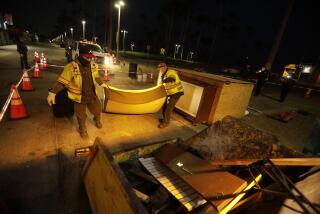A bankrupt Detroit, maybe down but never out
Last week, with a massive $18-billion debt, Detroit became the largest American city to seek bankruptcy protection, and once again we are reading obituaries of the late, great Motor City.
I don’t pretend to be an expert on Detroit, where I once worked for three years, but the widely circulating conservative analyses that lay blame for the city’s woes at the feet of Democrats and big labor are infuriatingly off base.
The decline of Detroit is an American tragedy with many causes, chief among them the foundering of the U.S. manufacturing sector. That’s not a Detroit problem; that’s an American problem.
Detroit is a spread-out city -- covering some 142 square miles -- and as its population has plunged from a high of 1.8 million people in the 1950s to fewer than 700,000 today, its neighborhoods have a hollowed-out feel. There just aren’t enough people to fill the space; some estimate that a quarter of the city is empty.
But there are no simple answers when it comes to Detroit. The recent spate of municipal corruption is appalling, but does little to explain the overall state of decay in Detroit.
As my former colleague Scott Martelle, author of “Detroit: A Biography,” wrote last March in The Times: “The emptying of Detroit stems from a complex mix of intractable racism, corporate and governmental decisions, failed institutions and crime levels that have driven most of the middle class to the suburbs. Local governments have regularly undercut each other with tax deals to lure jobs .… These deals have helped corporations at the expense of communities like Detroit, causing the city’s tax base to shrink faster than the city government could adapt and leaving it with massive debt, annual operating deficits, a demoralized workforce, an impoverished population base -- and no plan for how to fix things.”
To help stem the red ink, Michigan Gov. Rick Snyder has called for deep pension cuts for the city’s 21,000 retirees. Many American cities and counties with heavy pension obligations of their own are watching closely as the fight over the pensions takes center stage in court. The retirees argue that the Michigan Constitution does not allow their pensions to be cut. A federal judge is expected to decide whether the city can break its promise to the retirees.
In the late 1980s, I spent some of the most rewarding years of my career in Detroit, working for one of the city’s great newspapers. The place was in decline even then. White flight after the traumatic 1967 riots and middle-class migration was about to reduce the city’s population to below a million, the tax base was shriveling, the crack epidemic was in full swing and abandoned homes were a blight on many city blocks.
As the region’s industrial base crumbled, public schools struggled and the crime rate soared. Nothing seemed to work, but the city never stopped telling itself it was on the verge of a comeback. (There’s a reason the city’s biggest building project, funded in the 1970s by Ford Motor Co. was called the Renaissance Center.)
There were hopeful signs, some weirder than others. The city had completed a new public transportation system -- the People Mover -- an elevated rail line that took people in a mile-long circle around downtown. Funded with federal money, it just went in a big circle around the downtown, with no spokes out to the neighborhoods or beyond to the affluent suburbs. “We got the hole without the doughnut,” as some joked at the time. The People Mover never got the ridership that was predicted and never became profitable.
Last fall, I spent a few days in Detroit when I was in Michigan to report on the presidential campaign, and its native son, the GOP candidate Mitt Romney. (He lost big in Michigan, having badly hurt himself by urging the federal government to let the car companies go bankrupt in 2008. My old newspaper, the Detroit Free Press, had left its longtime building years before and moved down the street into the building of its one-time competitor, the Detroit News, with whom it has had a joint-operating agreement. The old Free Press building is abandoned now, its windows boarded, big planters on the sidewalk outside sprouting weeds.
Yet there were many signs of life in the city’s core: a new stadium for the Tigers, a renovated opera house, lots of new business including the headquarters for Quicken Loans, which had moved thousands of employees downtown from the suburbs. Other great city institutions have committed to long-term growth and investment. Henry Ford Hospital has announced a billion-dollar expansion, Wayne State University a $90-million tech center and so on.
But the plight of the city’s residential neighborhoods still came as a shock. While Detroiters have objected to what they see as a prurient interest in the city’s decay -- “ruin porn” they have dubbed it -- it’s worth anyone’s while to drive around Detroit to see what happens when a city implodes.
Dilapidated houses with collapsing roofs and porches are a common sight. Many have been bulldozed, leaving pock marks on every block. In some places, the empty lots give the impression that the still-intact homes have huge, impressive yards. Some residential streets in the middle of the city looked like country lanes.
One of the saddest aspects of the Detroit dynamic is the contrast between the suffering black city and its affluent white suburbs. Not that other cities are not segregated; of course they are. But the racial segregation is so stark, and the contrast between city and suburb are so dramatic, that you feel you are witnessing something akin to a passive form of apartheid. Venture across the city’s northern boundary, Eight Mile Road, or across the city’s eastern boundary into the tony Grosse Pointes, and you feel you are in a different world. It’s hard to believe the places are related by a common economy.
Detroit is not my city and it never will be.
But it will always claim a small piece of my heart. If you’ve ever spent a meaningful amount of time there, you can’t help but love the place.
Like America herself, it’s a city that’s often down, but never out.
[For the Record, 11:08 p.m. July 23: An earlier version of this post said Michigan’s governor is Rick Scott. It is Rick Snyder. Florida’s governor is Rick Scott.]
ALSO:
Victim of Hyde Park hit-and-run mourned; suspect remains at large
AEG offered Michael Jackson estate $60 million for Las Vegas show
San Francisco bicyclist pleads guilty to felony in pedestrian’s death
More to Read
Start your day right
Sign up for Essential California for news, features and recommendations from the L.A. Times and beyond in your inbox six days a week.
You may occasionally receive promotional content from the Los Angeles Times.







